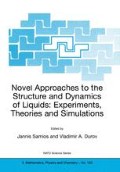Abstract
The aim of this contribution to the summer school is to show how atomistic computer simulations can be used to study and interpret vibrational relaxation in solutions. In the first part of the article the three distinct relaxation rates (population relaxation T , decoherence rate T -12 and the pure dephasing rate (T2*)-1) are introduced and theoretical expressions for the rates involving solventsolute forces and solute-solvent energy derivatives are developed from perturbation theory. In the second part the way in which relaxation rates can be determined from simulations of flexible molecules is illustrated using the example of the stretching modes of the triiodide ion. The origin and explanation of the variations in rate are then discussed combining data from simulations of rigid solute molecule and the expressions from perturbation theory.
Access this chapter
Tax calculation will be finalised at checkout
Purchases are for personal use only
Preview
Unable to display preview. Download preview PDF.
References
Allen, M. P. and Tildesley, D. J. (1994) Computer Simulation of Liquids, Clarendon Press, Oxford.
Oxtoby, D. W., Levesque, D. and Weis, J. J. (1978) A molecular dynamics simulation of dephasing in liquid nitrogen, J. Chem. Phys. 68, 5528–5533.
Levesque, D. and Weis, J. J. (1980) A molecular dynamics simulation of dephasing in liquid nitrogen. II. Effect of the pair potential on dephasing, J. Chem. Phys. 72, 2744–2749.
Levesque, D., Weis, J. J. and Oxtoby, D. W. (1983) A molecular dynamics simulation of rotational and vibrational relaxation in liquid HC, J. Chem. Phys. 79, 917–925.
Chesnoy, J. and Weis, J. J. (1986) Density dependence of the dephasing and energy relaxation times by computer simulation, J. Chem. Phys. 84, 5378–5388.
Westlund, P. O. and Lynden-Bell, R. M. (1987) A study of vibrational dephasing of the A1 modes of CH3CN in computer simulation of liquid phase, Mol. Phys. 60, 1189–1209.
Lynden-Bell, R. M. and Westlund, P. O. (1987) The effects of pressure and temperature on vibrational dephasing in a simulation of liquid CH3CN, Mol. Phys. 61, 1541–1547.
Postma, J. P. M., Berendsen, H. J. C. and Straatsma, T. P. (1984) Intramolecular vibrations from molecular dynamics simulations of liquid water, J. Phys. C4, 31–40.
Chorny, I., Vieceli, J. and Benjamin, I. (2002) Molecular dynamics study of the vibrational relaxation of OCIO in bulk liquids, J. Chem. Phys. 116, 8904–8911.
Poulsen, J., Nymand, T. M. and Keiding, S. R. (2001) Asymmetric stretch vibrational energy relaxation of OC1O in liquid water, Chem. Phys. Lett. 343, 581–587.
Morita, A. and Kato, S. (1998) Vibrational relaxation of azide ion in water: The role of intramolecular charge fluctuation and solvent-induced vibrational coupling, J. Chem. Phys. 109, 5511–5523.
Diraison, D., Guissani, Y., Leicknam, J. C. and Bratos, S. (1996) Femtosecond solvation dynamics of water: solvent response to vibrational excitation of the solute, Chem. Phys. Lett. 258, 348–351.
Margulis, C. J., Coker, D. F. and Lynden-Bell, R. M. (2001) A Monte Carlo study of symmetry breaking of I3- in aqueous solution using a multistate diabatic Hamiltonian, J. Chem. Phys. 114, 367–376.
Margulis, C. J., Coker, D. F. and Lynden-Bell, R. M. (2001) Symmetry breaking of the triiodide ion in acetonitrile solution, Chem. Phys. Lett. 341, 557–560.
Zhang, F. S. and Lynden-Bell, R. M. (2002) A simulation study of vibrational relaxation of I3 in liquids, submitted for publication.
Zhang, F. S. and Lynden-Bell, R. M. (2002) Pure vibrational dephasing of triiodide in liquids and glasses, Mod. Phys. Lett. in press.
Lynden-Bell, R. M. and Zhang, F. S. (2002) in preparation.
Oxtoby, D. W. (1979) Dephasing of molecular vibrations in liquids, Adv. Chem. Phys. 40, 1–48.
Okazaki, S. (2001) Dynamical approach to vibrational relaxation, Adv. Chem. Phys. 118, 191–270.
Rothschild, W. G. (1984) Dynamics of Molecular Liquids Wiley-Interscience, New York.
Bader, J. S. and Berne, B. J. (1994) Quantum and classical relaxation rates from classical simulations, J. Chem. Phys. 100, 8359–8366.
Egorov, S. A. and Skinner, J. L. (1996) A theory of vibrational energy relaxation in liquids, J. Chem. Phys. 105, 7047–7058.
Egorov, S. A., and Berne, B. J. (1997) Vibrational energy relaxation in the condensed phases: Quantum vs classical bath for multiphonon processes, J. Chem. Phys. 107, 6050–6061.
Cherayil, B. J. and Fayer, M. D. (1997) Vibrational relaxation in supercritical fluids near the critical point, J. Chem. Phys.107, 7642–7650.
Rostkier-Edelstein, D., Graf, P. and Nitzan, A. (1997) Computing vibrational energy relaxation for high-frequency modes in condensed environment, J. Chem. Phys. 107, 10470–10479.
Kubo R. (1963) Stochastic processes in chemical physics. Adv Chem. Phys. 13, 101–127.
Whitnell, R. M., Wilson, K. R. and Hynes J. T. (1990) Fast vibrational relaxation for a dipolar molecule in a polar solvent, J. Phys. Chem. 94, 8625–8628.
Author information
Authors and Affiliations
Editor information
Editors and Affiliations
Rights and permissions
Copyright information
© 2004 Springer Science+Business Media Dordrecht
About this chapter
Cite this chapter
Lynden-Bell, R.M., Zhang, F.S. (2004). Using Simulations to Study Vibrational Relaxation of Molecules in Liquids. In: Samios, J., Durov, V.A. (eds) Novel Approaches to the Structure and Dynamics of Liquids: Experiments, Theories and Simulations. NATO Science Series, vol 133. Springer, Dordrecht. https://doi.org/10.1007/978-1-4020-2384-2_18
Download citation
DOI: https://doi.org/10.1007/978-1-4020-2384-2_18
Publisher Name: Springer, Dordrecht
Print ISBN: 978-1-4020-1847-3
Online ISBN: 978-1-4020-2384-2
eBook Packages: Springer Book Archive

